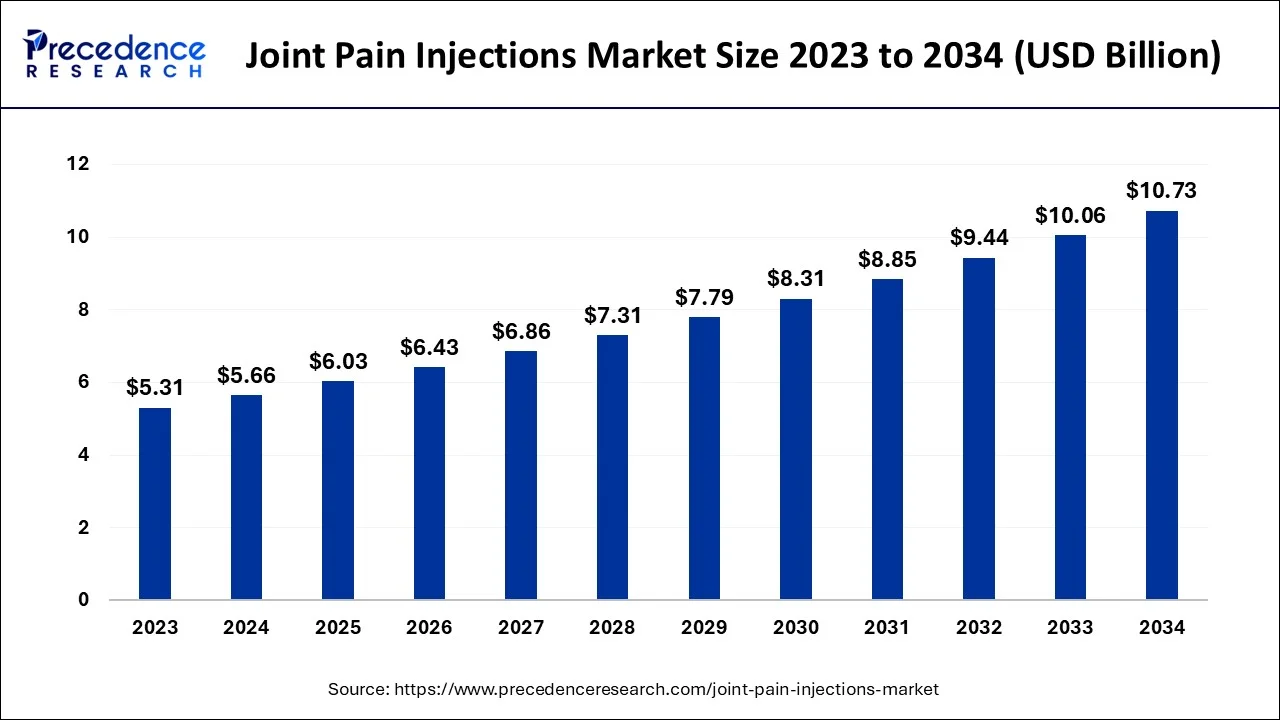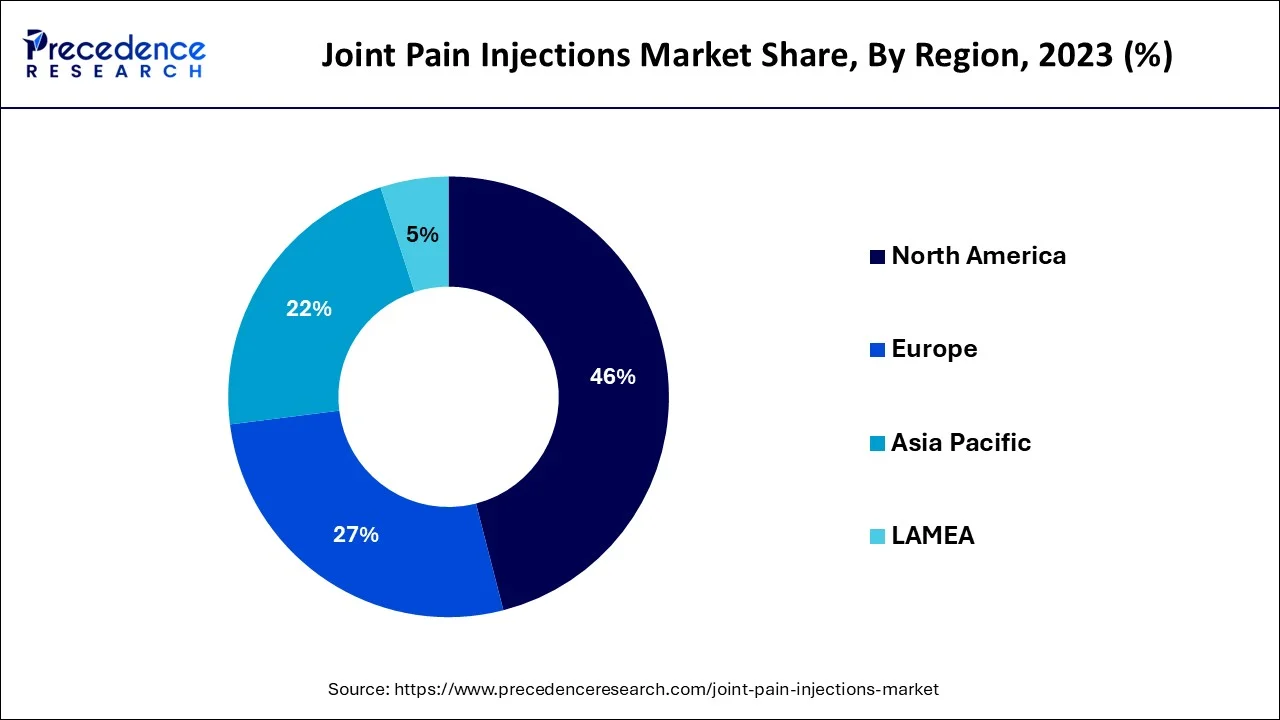April 2025
The global joint pain injections market size accounted for USD 5.66 billion in 2024, grew to USD 6.03 billion in 2025 and is projected to surpass around USD 10.73 billion by 2034, representing a healthy CAGR of 6.60% between 2024 and 2034.
The global joint pain injections market size is estimated at USD 5.66 billion in 2024 and is predicted to surpass around USD 10.73 billion by 2034, expanding at a CAGR of 6.60% between 2024 and 2034.

Based on the region, the North America segment dominated the market in 2023, in terms of revenue. This is attributed to the easy availability of anabolic steroids, greater public awareness about the personal health, and increased demand among professional athletes and sportspersons.

The Asia-Pacific is estimated to be the most opportunistic segment during the forecast period. This is attributed to the high acceptance of viscosupplementation in the U.S., increased prevalence of joint-related disorders, technological advancements, an increase in ageing population, and a high prevalence of healthcare spending in the region, North America is expected to grow at a rapid pace.
Any of the ligaments, bursae, or tendons that surround the joint can be injured, causing joint discomfort. Joint pain injections are medications that are injected directly into the joints to assist reduce inflammation and discomfort in the patient. Inflammatory joint disorders such as psoriatic arthritis, rheumatoid arthritis, bursitis, osteoarthritis, gout, and other types of joint pain are commonly treated with joint pain injections, also known as intra-articular injections.
Arthritis is a joint illness characterized by symptoms such as joint pain, stiffness, redness, and a decrease in physical activity. Osteoarthritis, or degenerative joint disease, and rheumatoid arthritis, an inflammatory illness affecting the feet and hands, are the two most frequent types of arthritis. Osteoarthritis can develop as a result of a loss of bone mineral density, rising obesity rates, age, and a lack of physical activity. Injections of corticosteroids and hyaluronic acid are commonly used to relieve inflammation and discomfort in afflicted joint locations.
The rising frequency of arthritis and musculoskeletal problems is fueling demand for joint pain injections, particularly among people aged 65 and over, who are more prone to joint discomfort. However, a lack of awareness about these injections, as well as the expensive cost of the medicines, may limit the market’s expansion.
The global joint pain injections market is expected to be driven by a growth in the elderly population, an increase in the frequency of joint disorders, and high unmet medical needs over the forecast period.
The majority of joint diseases are diagnosed in elderly persons. Placental tissue matrix and platelet-rich plasma injections, according to the research, have demonstrated to be helpful in lowering inflammation, discomfort, and infection rates at the joint site. The rising prevalence of arthritis, the growing geriatric patient population, and the increasing number of new product releases by numerous key players are all expected to fuel the expansion of the joint pain injections market over the forecast period.
Government organizations’ increasing spending in research and development in the creation of novel and cost-effective medicines are factors driving the growth of the joint pain injections market over the forecast period.
During the projected period, the global joint pain injections market is expected to rise due to an increase in the prevalence of osteoarthritis and an increase in the need for cost-effective therapies. Moreover, the expanding ageing population and technological advancements are expected to propel the joint pain injections market further throughout the forecast period.
However, the shortage of arthritis specialists in developing countries and the high cost of treating arthritis are projected to restrain the global joint pain injections market’s growth over the forecast period.
The rising prevalence of osteoarthritis across a large portion of the population could be a key growth driver for the joint pain injections market. The market for global joint pain injections may benefit from the shift in demand for minimally invasive operations.
Osteoarthritis affects more than 32.5 million persons in the U.S., according to the Centers for Disease Control and Prevention. These frightening statistics highlight the urgent need for osteoarthritis treatment, driving up demand for joint pain injection during the forecast period.
| Report Coverage | Details |
| Market Size In 2024 | USD 5.66 Billion |
| Market Size By 2034 | USD 10.73 Billion |
| Growth Rate From 2024 to 2034 | CAGR of 6.60% |
| Largest Market | North America |
| Fastest Growing Market | Asia Pacific |
| Base Year | 2023 |
| Forecast Period | 2024 to 2034 |
| Segments Covered | Injection Type, Distribution Channel, Region |
| Regions Covered | North America, Europe, Asia-Pacific, Latin America and Middle East & Africa |
Based on the injection type, the hyaluronic acid injections dominate the joint pain injections market during the forecast period. The increasing desire for aesthetic beauty, driven by the less invasive nature of the treatments and the increasing efficiency of the hyaluronic acid injections, is one of the key factors driving the hyaluronic acid injections segment. The advent of new products and related new indications, as well as increased awareness of hyaluronic acid injections in developed and developing countries, are fueling the hyaluronic acid injections segment expansion.
The corticosteroid injections is expected to grow at rapid pace during the forecast period. The increased occurrences of bone and joint illnesses, rising obesity rates globally, changing and unhealthy lifestyles of people, and rising government awareness programs for joint problems are some of the factors that would propel the growth of corticosteroid injections market during the forecast period.
Based on the distribution channel, the retail pharmacies dominate the joint pain injections market during the forecast period. The joint pain injections are mostly purchased from retail pharmacies. Therefore, it is expected to grow at a rapid pace.
The online pharmacies segment is expected to grow at rapid pace during the forecast period. The rising internet penetration in the emerging nations is driving the growth of segment. Also, the trend of digitalization has contributed towards the growth of online pharmacies segment to the greater extent.
Segments Covered in the Report
By Injection Type
By Joint Type
By Distribution Channel
By Product Type
By Geography
For inquiries regarding discounts, bulk purchases, or customization requests, please contact us at sales@precedenceresearch.com
No cookie-cutter, only authentic analysis – take the 1st step to become a Precedence Research client
April 2025
February 2025
August 2024
October 2024